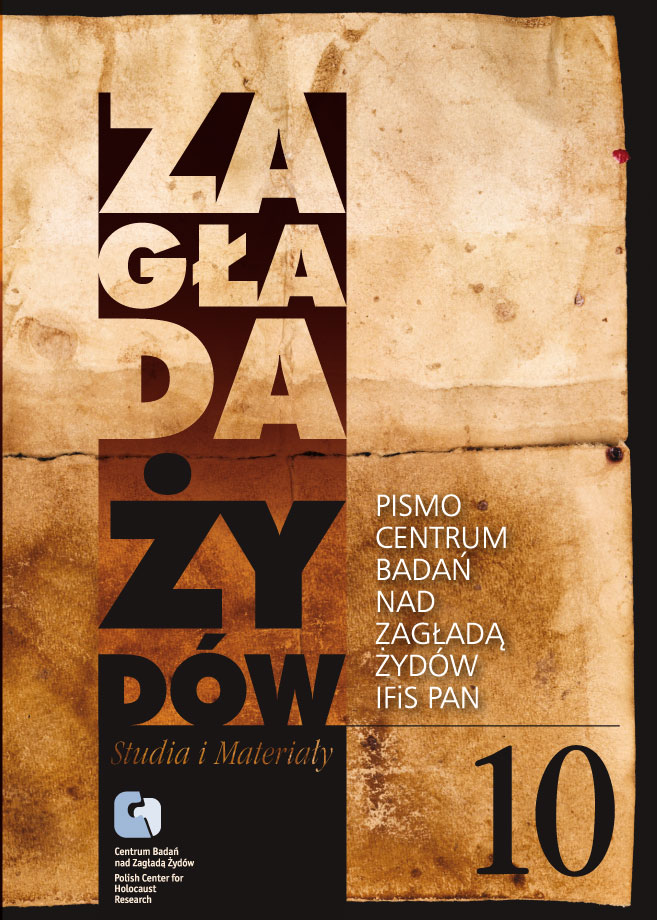Krzesiny i Kreising – między pamiętaniem a pomijaniem. Polskie miasteczko wobec historii, pamięci i rywalizacji w cierpieniu
Zagłada Żydów. Studia i Materiały, Nr 10 (2014), Strony: 443-461
Data zgłoszenia: 2020-10-22Data publikacji: 2014-12-01
 https://doi.org/10.32927/ZZSiM.532
https://doi.org/10.32927/ZZSiM.532
Abstrakt
The area around Krzesiny, located near the city of Poznań, Poland, witnessed several dark events during World War II: Germans oppressed the local population, culminating in a terrorizing action dubbed “akcja krzesińska;” also, a forced labor camp, named “Kreising,” was built near the township, housing mainly Jews. After the war, the suffering in Krzesiny was remembered, but selectively – “akcja” and other forms of Polish suffering were commemorated, while the camp was not. By exploring the “lieux de mémoire” in Krzesiny – dynamics of memory in a small township in Poland – this paper uses localized research to address the issue of gaps in collective memory and commemoration. We briefly look at the relevant history, Polish memory regarding wartime events in Krzesiny, and the postwar dynamics of collective memory. Discussing the latter, we identify a new phenomenon at work, one which we dub “collective disregard” – group neglect of the past of the “Other” that occurs without clear intent. We argue that “collective disregard” is an issue that naturally occurs in the dynamics of memory. By making a deliberate investment in balanced remembrance and commemoration, societies can counter the tendencies of “disregard” and curb the controversies of competitive victimization claims, also called “competitive martyrdom”.
Licencja
Prawa autorskie (c) 2014 Autor&"Zagłada Żydów. Studia i Materiały"

Utwór dostępny jest na licencji Creative Commons Uznanie autorstwa 4.0 Międzynarodowe.
https://creativecommons.org/licenses/by/4.0
Czasopismo publikowane jest w standardzie Diamond Open Access na licencji CC-BY-4.0 Deed - Uznanie autorstwa 4.0 Międzynarodowa - Creative Commons
Podobne artykuły
- Zuzanna Schnepf-Kołacz, Włoski ogród historii. Rzym, Ferrara, Mediolan – nowe projekty na mapie żydowskich muzeów we Włoszech , Zagłada Żydów. Studia i Materiały: Nr 9 (2013)
- Feliks Tych, Pamięci dr Ruty Sakowskiej, badaczki Holokaustu , Zagłada Żydów. Studia i Materiały: Nr 7 (2011)
- Grzegorz Krzywiec, Golden Harvest or Hearts of Gold? Studies on the Wartime Fate of Poles and Jews, edited by Marek J. Chodakiewicz, Wojciech J. Muszyński, Paweł Styrna (Washington DC: Leopolis Press, 2012); 370 pages. , Zagłada Żydów. Studia i Materiały: Nr Holocaust Studies and Materials (2013)
- Jan Olaszek, Żydzi i armia Andersa. Przypadek Romana Zimanda , Zagłada Żydów. Studia i Materiały: Nr 20 (2024)
- Adam Kopciowski, Jedynie bramy łez nie zamknęły się przed nami”. Bóg i Zagłada w listach lubelskiego rabina Hersza Majlecha Talmuda , Zagłada Żydów. Studia i Materiały: Nr 15 (2019)
- Karolina Panz, Zagłada sztetl Grice , Zagłada Żydów. Studia i Materiały: Nr 3 (2007)
- Krzysztof Persak, Wydmuszka. Lektura krytyczna Miast śmierci Mirosława Tryczyka , Zagłada Żydów. Studia i Materiały: Nr 12 (2016)
- Dariusz Libionka, The National Military Organization, the National Armed Forces and the Jews near Kraśnik: A Picture Corrected , Zagłada Żydów. Studia i Materiały: Nr Holocaust Studies and Materials (2013)
- Justyna Kowalska-Leder, Recenzja: Reprezentacje Zagłady w kulturze polskiej (1939–2019). Problematyka Zagłady w sztukach wizualnych i popkulturze, t. 1–2, red. Sławomir Buryła, Dorota Krawczyńska, Jacek Leociak, Warszawa: Wydawnictwo IBL PAN, 2021, 672 s. , Zagłada Żydów. Studia i Materiały: Nr 18 (2022)
- Agnieszka Haska, „Na tej fabryce nie pracują Żydzi”. Nieznana historia pomocy , Zagłada Żydów. Studia i Materiały: Nr 19 (2023)
<< < 1 2 3 4 5 6 7 8 9 10 11 12 13 14 15 16 17 18 19 20 21 22 23 24 25 26 27 28 29 30 31 32 33 34 > >>
Możesz również Rozpocznij zaawansowane wyszukiwanie podobieństw dla tego artykułu.
 English
English
 Język Polski
Język Polski




